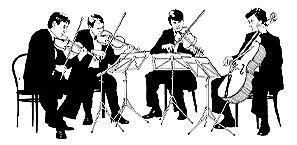 Ulvi Cemal Erkin (1906-1972) will always be remembered as the great composer of western music in Turkey. Having studied in France with famous teachers, Isidor Philipp for piano and Nadia Boulanger in composition, Erkin then traveled back to Turkey and brought with him the newest musical expression of the time. With these tools he challenged all Turkish composers to accept and assimilate the new modern musical language. He never neglected his heritage, however, and frequently incorporated Turkish motifs into a sometimes impressionistic, sometimes neo-classical language. His Sinfonietta for string orchestra was written between 1951 and 1959 is in three movements: Allegro, Adagio, Allegro.
Ulvi Cemal Erkin (1906-1972) will always be remembered as the great composer of western music in Turkey. Having studied in France with famous teachers, Isidor Philipp for piano and Nadia Boulanger in composition, Erkin then traveled back to Turkey and brought with him the newest musical expression of the time. With these tools he challenged all Turkish composers to accept and assimilate the new modern musical language. He never neglected his heritage, however, and frequently incorporated Turkish motifs into a sometimes impressionistic, sometimes neo-classical language. His Sinfonietta for string orchestra was written between 1951 and 1959 is in three movements: Allegro, Adagio, Allegro.
By Steven Ledbetter, BUPS
(The following is translated from essays by Naile Mehtiyeva)
Rauf Haciyev (1923-1997) is considered an eminent representative of contemporary Azerbaijaini music. He studied at Baku Conservatory with Karayev. He composed songs, operettas, symphonic pieces, and music for films and plays. His works have played a major role in the development of Azerbaijani music. His close ties with folk art and abundant melodism stand out as the distinguishing marks of his work.
Haciyev's Violin Concerto, which he composed in 1952, has a special place among his works. The concerto reflects a brilliant, youthful spirit. It has the traditional three sections. The first section, allegro, voices the dynamic, energetic, and vivid motifs of folk dances. The second section (moderato cantabile) is more like a lyric folk song, calm and attractive. In the second section (andante sostenuto) the main theme is presented by the soloists in an extemporaneous style, creating an emotional, sad, and melancholy mood. By the end the tempo becomes faster and the beginning of the bright and joyous finale is evident. The final section (allegro con brio) presents a colorful picture describing a folk festivity with a well-woven rhythm of dynamic music.
Shostakovich, one of the greatest composers of the 20th century, made the following comment about Fikret Amirov (1922-1984): "Amirov is a composer with rich, melodic ability. The melody is the spirit of his creativity. In his works he uses Azerbaijani folklore."
The Nizami Symphony is one of Amirov's masterpieces. He dedicated the piece to great Azeri poet and philosopher Nizami, who lived in the 12th century. The first section (moderato maestoso), in sonnet form, starts with a slow introduction, and the second section (allegretto) is a vivid scherzo decorated by colorful tunes and slow dance rhythms. The third section attempts to reflect the beauty and love expressed in Nizami's poetry. The fourth section (allegro) is the pinnacle of the entire symphony. The symphony ends with a lietmotif framing the entire composition.
Program for Tuesday, February 23
Conductor Prof. Server Ganiyev,
Violin soloist Toğrol Ganiyev.
U.C. Erkin: Sinfonietta.
F. Amirov: Nizami Symphony.
R. Haciyev: Violin Concerto.
Faculty of Music and Performing Arts Auditorium, 9 p.m.
For more information and reservations, call 266-4382.








